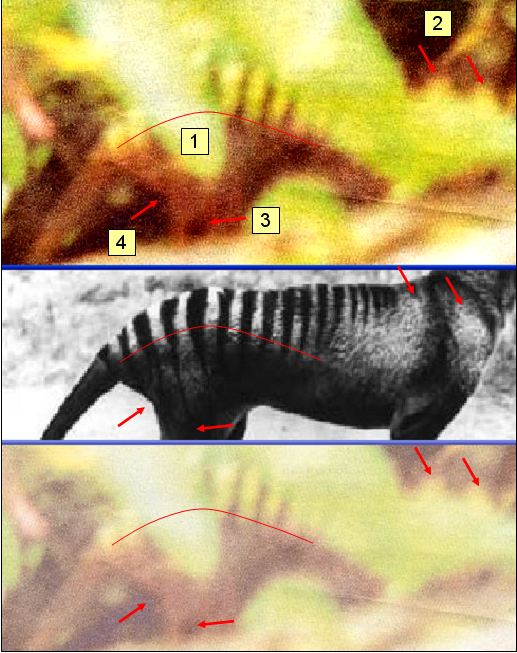Emmerichs thylacine - Fleay photograph overlay
Interlude (part 3)
We're between postings here at Where Light Meets Dark and over at Cryptomundo, Alton Higgins has submitted an excellent series of images (since removed) which overlays the covering photograph from Robert Paddle's book, "The Last Tasmanian Tiger" onto one of Mr Emmerichs' February 2005 photograph.
The results are very interesting.
The match is more than a little perfect. As noted by Col Bailey of the Tasmanian Tiger Research and Data Centre in the original contribution by Mike Williams at Cryptomundo, the newspaper images were "distored ... somewhat to guard against reproduction."
My guess is that this accounts for the somewhat flourescent appearance of the thylacine's stripes. In fact, the greenish "stripes" are more likely to correlate with the usual tan fur colour of the thylacine. If you take a careful look at the photograph on Paddle's book (see centre image in Figure, below), there is quite a high contrast between the dark and light portions in that photo. In particular, the brightest areas tend to follow an arc, similar in shape to a rainbow. This correlates closely to Mr Emmerichs' photo.
Figure 05 - Comparison with David Fleay's photograph.
This image shows the 1933 photograph depicted on the cover of Robert Paddle's book "The Last Tasmanian Tiger" (where it is credited to the Archives Office of Tasmania) at centre (black and white), together with two versions of Mr Emmerichs' February 2005 photograph (high contrast at top, and as published at Cryptomundo at bottom).
When considering the following points, note that the centre image may not be presented to exactly the same scale as the other two images. It was taken from the series of overlays presented by Alton Higgins at Cryptomundo.
The curve labelled "1" runs through the bottom edges of the highest-contrast white portions of the animal's stripes. It is identical in size and orientation in all three images.
The two arrows labelled "2" indicate two portions of high contrast pale fur colour on the animal's shoulder. The two arrows are equally spaced and oriented the same way in all three images.
The arrow labelled "3" shows a darker colouration which is visible in Mr Emmerichs' photo, but not in the 1933 print. Further adjustment of the 1933 image may yet indicate that this patch is present in the 1933 photo also. This analysis will be presented here at Where Light Meets Dark.
The arrow labelled "4" shows a significant change in the curve between the animal's hind leg and the thick base of the animal's tail. The deviation is present in all images in approximately the same location.
Arrows 3 and 4 are equally spaced and oriented the same way in all three images.
The correlation between Mr Emmerichs' photo and the 1933 print is fairly high, even with the poor quality reproductions.
Perhaps the most obvious correlation hasn't yet been mentioned here: the number positioning and spacing of the white portions between the dark stripes all correlate strongly also.
Paddle (2000) notes that "observation of photographs of live and dead thylacines demonstrates that enormous variability existed in banding patterns, concerning the total number of stripes, how far down the body and thighs they extended, and whether they were straight or curved, tapering to a single point or ending in a fork".
Given that the norm is for difference in appearance, and similarity is the exception, Mr Emmerichs' thylacine is looking all the more remarkable if it is a genuine 2005 specimen.
However, as previously noted, photographs (no matter how clear) will almost certainly never provide conclusive evidence of the existance of the thylacine. Contrawise - the fact that the thylacine in Mr Emmerichs' photo so closely correlates to a known photo of a 1933 specimen, does not automatically guarantee that the photo is not genuine.
The plot thickens.
Copyright notice
The Emmerichs photographs, and derivative works, were removed from the former version of this website (at www.wherelightmeetsdark.com) in 2006 on request of Klaus Emmerichs. They were republished on 12 June 2019 under the defence of Fair Dealing under Australian copyright law. The original images and their elements as incorporated in derivative works are presented as they were published in the print version of Tasmanian newspaper, the Sunday Tasmanian in 2006. An attempt was made to contact Mr Emmerichs on 17 Mar 2017 ahead of the re-publication of these images but he could not be reached. For full details on how WLMD respects and supports copyright, please refer to the Terms and conditions of use. This note added 12 June 2019.
References
Paddle, R. (2000) 'The Last Tasmanian Tiger: The History and Extinction of the Thylacine', Cambride University Press, 45.
Revisions
12 June 2019 - Republish image, minor caption changes and copyright notice.
